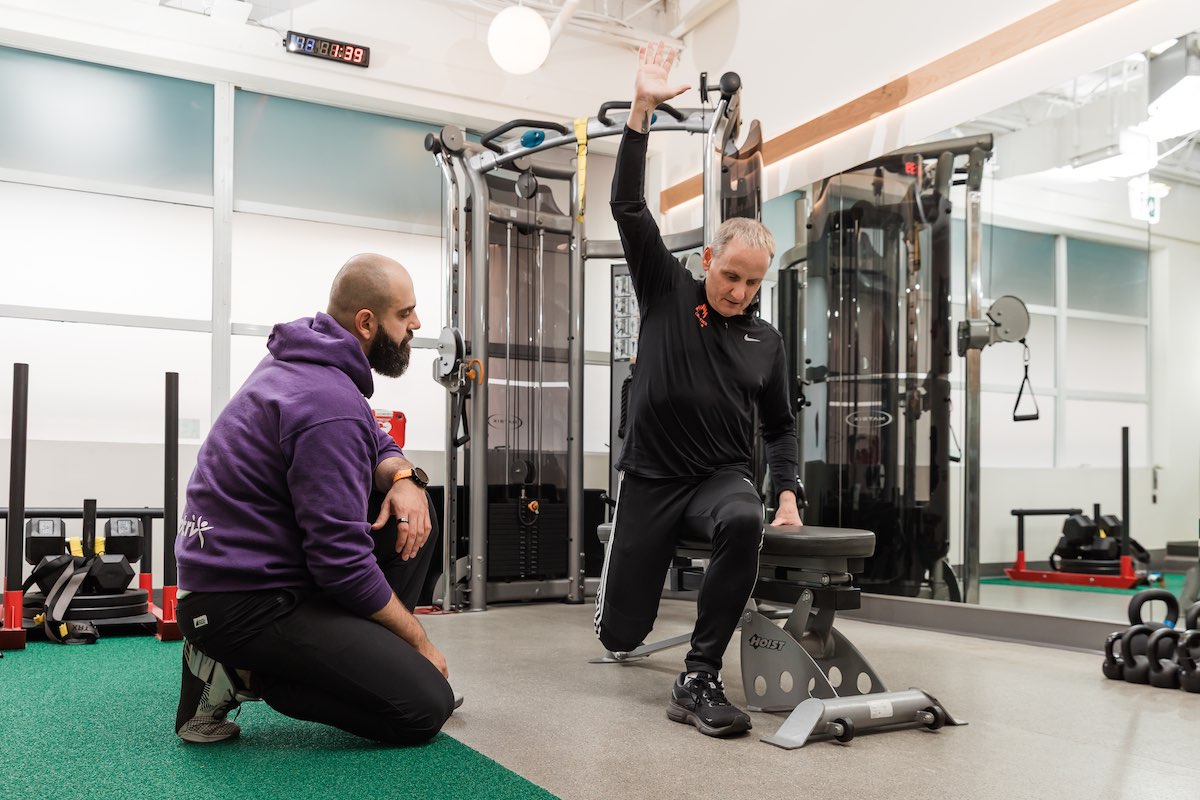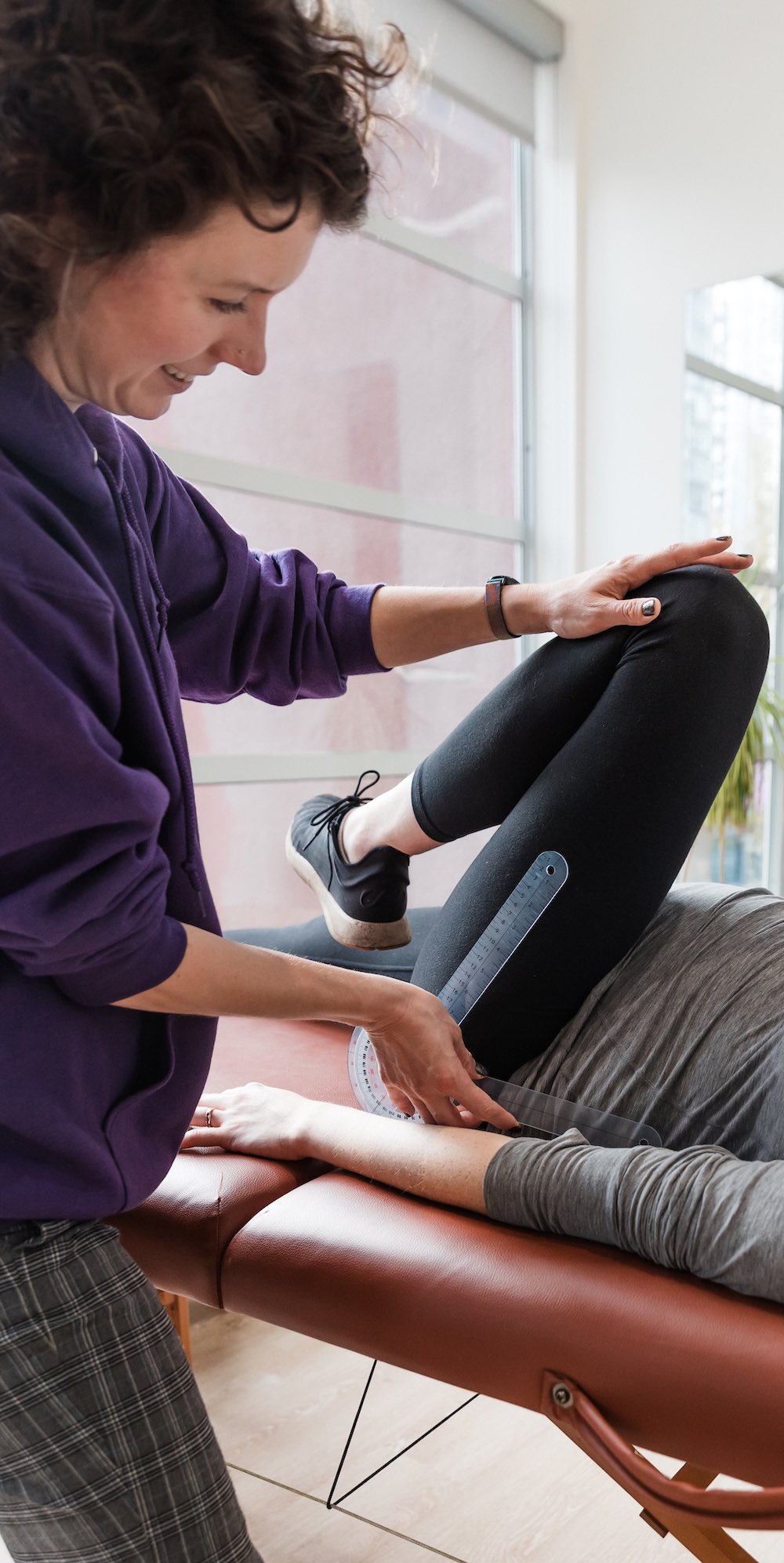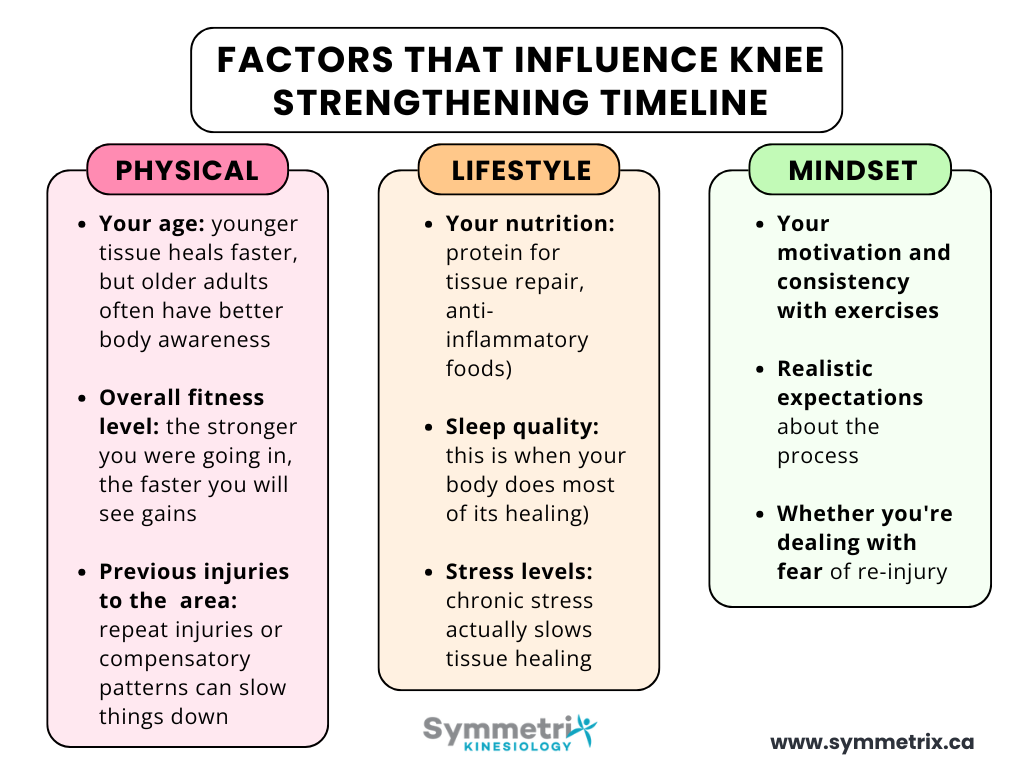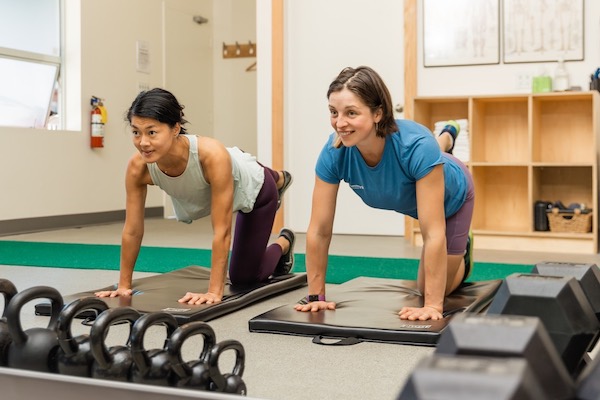
One year after your knee injury, you're still experiencing pain during everyday activities like climbing stairs or sports. Despite following basic rest and ice protocols, your knee feels unstable, and you're worried about re-injury every time you move.
Sound familiar? Just know this is super common.
As a certified kinesiologist with over 8 years leading a team specializing in movement and knee rehabilitation, I've seen clients stuck in this exact situation. The frustrating part is that most people think they just need to "wait it out" or rely on basic stretches they found online. But here's what I've learned from working with hundreds of knee strengthening cases: recovery isn't just about time, it's about following the right evidence-based knee strengthening strategies at the right phases.
I’ll share evidence-based knee strengthening strategies that help my clients achieve full recovery, even when previous treatments have failed. These are the same protocols we use in our clinic that have helped clients return to soccer, basketball, tennis, and their daily activities stronger than before.
Key Takeaways
- Start with VMO activation: Before any advanced knee strengthening, you must first activate your VMO (vastus medialis oblique) muscle through quad sets and straight leg raises to stabilize your kneecap.
- Follow a progression: Start with a focus on basic activation (~days 1-14), then build functional strength (~weeks 2-6), and finally develop power and advanced strength (~weeks 6-12).
- Avoid the biggest mistake: Doing too much too soon will set back your progress so start with minimal discomfort (2-3/10 pain scale) and progress by only 10-20% each week.
- Know when to get help: See a kinesiologist immediately if you can't bear weight, have severe swelling lasting over 48 hours, or if your knee locks up and won't bend easily.
Read on to learn the steps of knee strengthening that most people skip, specific exercises that accelerate healing, common mistakes that delay recovery by months. Find out exactly how to safely return to your favourite activities. And by the way, Symmetrix is currently accepting clients to our knee strengthening program. Book a free consultation with a kinesiologist to learn more.
What exercises help improve knee strength?
The two foundational exercises that should form the backbone of every knee strengthening program are straight leg raises and quad sets. These activate the muscles around your knee without putting stress on the joint itself.
Straight Leg Raises:
- Lie flat on your back with your leg straight
- Tighten your thigh muscle (quadriceps) and lift your leg 6-12 inches off the ground
- Hold for 5 seconds, then slowly lower
- Start with 10 repetitions, 3 times daily
- Progress by adding ankle weights once you can complete 15 reps easily
Quad Sets:
- Sit with your leg straight out in front of you
- Tighten your thigh muscle by pushing your knee down toward the floor
- You should see your kneecap pull upward slightly
- Hold for 5 seconds, then relax
- Repeat 10 times, several times throughout the day
These exercises specifically target your VMO (vastus medialis oblique). This muscle is part of your quad muscle that acts as a knee stabilizer. If your kneecap isn't stable, your knee might click, make weird noises, or feel like it's going to give out. Starting with these two exercises helps restore that stability before moving to more challenging movements.
Understanding Your Knee Strengthening Timeline
How Long Does It Take to Improve Knee Strength?
My honest answer when someone asks how long to strengthen their knee? It really depends on your starting point. But here's what I tell my clients based on the most common situations I see: basic weakness and minor injuries typically show significant improvement around 6 weeks, while post-surgical knee strengthening can take up to 6 months for full strength return.
Your knee strengthening speed isn't just about your starting point. Physical factors like your age and overall fitness level make a huge difference. The stronger you are overall, the faster you will gain strength. If you have an injury, previous injuries to the same area or even muscle imbalances can slow things down because your body has developed compensation patterns over time.
Lifestyle factors play a bigger role than most people realize. Your nutrition affects tissue repair, sleep quality is when your body does most of its healing, and chronic stress actually slows the strengthening process. But honestly, consistency with exercises is probably the biggest factor I see in my clinic.
Mindset factors can either accelerate or derail your progress. I had one client who was convinced she'd never play tennis again after her knee surgery. Her fear was actually holding back her progress more than the physical limitations. Once we worked on building confidence through gradual exposure, her knee strengthening progressed much faster.
Essential Knee Strengthening Exercises
Phase 1: Basic Activation (Days 1-14)
The first thing I do when someone comes into our clinic is check if they can activate their VMO properly. This vastus medialis oblique muscle is part of your quad, but it's specifically a knee stabilizer that keeps your kneecap stable.
During the first two weeks, you'll focus on quad sets multiple times daily, straight leg raises three times daily with 10 reps each, and gentle range of motion work. Heel slides where you're lying down slowly bending and straightening your knee help restore basic movement, and gentle calf raises are fine if they're comfortable.
I prefer doing mobility work through what we call "eccentric strengthening". It means getting your muscles to work while they're lengthening. This gives you range of motion improvements while also building strength, rather than just static stretching.
Phase 2: Functional Strengthening (Weeks 2-6)
Once you can activate your VMO properly, we start introducing more challenging movements that build real knee strength. This phase is where most people start feeling like they're making real progress because the exercises begin to mimic daily activities.
Wall squats or ball squats using a stability ball against the wall for support are perfect starting points. Sit-to-stand from a chair is basically a supported squat that you do naturally throughout the day anyway. Knee extensions and leg curls with resistance bands target specific muscle groups, while step-ups on a low step starting with just 4-6 inches height work your entire leg.
Glute bridges activate your glutes and hamstrings depending on foot position, and split squats are much easier than full lunges but still challenge your balance and strength. Here's a practical tip: if you can't do a full squat yet, try using a TRX or holding onto something for balance support. You can also limit your range of motion, the less range you use the easier it is. As you get stronger you can gradually go lower and lower.
Phase 3: Power and Advanced Knee Strengthening (Weeks 6-12)
This is where we really improve knee strength for real-world activities and sports. We're moving beyond basic strength into power, agility, and dynamic control that prepares you for whatever life throws at you.
Single leg exercises like single leg squats and single leg deadlifts are game-changers because they force each leg to work independently. More challenging balance work such as single leg balance with eyes closed trains your proprioception (your body's ability to know where it is in space). Progressive loading of squats and deadlifts with added weight builds serious strength.
Lunges in multiple directions including forward, reverse, and lateral movements prepare you for real-world scenarios where you need to move in all planes of motion. Jump training starts with small hops and progresses to proper landing mechanics, which is huge for preventing future injuries. Agility work with cutting movements and direction changes gets you ready for sports like soccer, basketball, or tennis where you need to move quickly and change directions.
Milestone Checklist: Signs You're Ready for the Next Phase
Ready for Phase 2 (Functional Strengthening):
- ✓ Can activate VMO muscle properly
- ✓ Pain with daily activities is manageable (3/10 or less)
- ✓ Can perform 15 straight leg raises without pain
Ready for Phase 3 (Power/Advanced Knee Strengthening):
- ✓ Can perform 20 single leg squats with good form
- ✓ Can do 25 single leg calf raises
- ✓ Can perform 20 single leg hamstring bridges
- ✓ Can balance on one leg for 30 seconds with eyes closed
Professional vs. DIY Knee Strengthening
The biggest difference between professional knee strengthening and trying to figure it out on your own comes down to assessment. Each person compensates in their own unique ways, and these compensation patterns are usually invisible to the person doing them.
When someone comes into our clinic, I take them through a comprehensive assessment process. I'm looking at how they squat, how they deadlift, and whether there are any barriers to these activities. Based on what I observe, I'm marking things down and looking for imbalances that could be setting them up for problems.
For example, let's say someone can do 10 really nice deadlifts without any bother, but they can't even do a single squat. For me, that's a clear mismatch between their quads and hamstrings. The mismatch is a dysfunctional movement pattern that needs specific attention. So instead of focusing on deadlifts which they already can do well, we're going to focus more on getting their squat down so they can have more functional movement.
A professional assessment catches compensation patterns you can't see yourself, identifies strength imbalances between muscle groups, determines when you're ready to progress safely, and spots red flags that need immediate attention. The DIY approach works when you have experience with exercise and good body awareness, your issues are minor and you're progressing well, you're using evidence-based protocols, and you're honest about your pain levels and limitations.
Anyone who struggles to do exercises on their own should see a kinesiologist. These clients get huge value from accountability and someone watching you to make sure you're doing movements correctly. This is especially true if you've never exercised before or you're not sure about proper form.

Common Knee Strengthening Mistakes
Doing Too Much Too Soon
This is probably the biggest mistake I see in my clinic. People get really upset about having weakness or being injured and push way too hard with their knee strengthening exercises. They don't feel weak so they don't listen to their bodies during rehab and try to make up for lost time.
Here's what happens: pushing too hard actually sets you back because you end up with more pain than when you started. I've seen clients who were making good progress suddenly have a major flare-up because they got impatient and tried to jump ahead in their recovery timeline.
You'll know you're doing too much if you have pain that's worse the day after exercise, increased swelling or stiffness, or you suddenly need pain medication when you hadn't before. Finding the right intensity means starting with exercises that cause minimal discomfort - maybe 2-3 out of 10 on the pain scale. You should feel like you could do a few more reps when you finish a set. Some muscle fatigue is normal, joint pain is not. Progress these exercises by 10-20% each week, not 50-100%.
Ignoring Pain Signals vs. Normal Discomfort
Learning the difference between pain signals you should pay attention to and normal exercise discomfort is one of the most important skills in knee strengthening. Your body is really smart, it will make pain signals louder if you keep ignoring them.
You need to stop immediately if you feel sharp or shooting pain, pain that gets progressively worse during the exercise, or any pain that makes you feel like your knee might give out. These are your body's warning signals that something isn't right.
Normal discomfort during knee strengthening includes mild muscle fatigue or burning during exercise, general achiness that goes away within 30 minutes after exercise, and muscle soreness 24-48 hours after starting new exercises. The tricky part is that some discomfort during strengthening is actually normal and expected. If you avoid all discomfort, you'll never make progress.
Skipping the Mobility Phase
I find that a lot of people make the mistake of only stretching, especially at the beginning of their knee strengthening program. I hear this constantly from clients: "I went to physio and they did a few things, then gave me some stretches to do at home."
I understand why. It’s because most practitioners are trying to control pain first, so they give stretches to help clients feel better before they can start doing exercises. But I actually believe we can manage pain through gentle movement and building strength rather than just static stretching.
I prefer dynamic mobility over static stretching because you're working on range of motion AND strength at the same time. It's more functional because you're training movements you actually use in daily life. For example, instead of just stretching your hamstring by reaching for your toes, we might do the slow lowering phase of a bridge exercise. You're getting the hamstring length you need while also teaching it to be strong in that lengthened position. Static stretching definitely has its place, but relying only on stretching, especially early in your knee strengthening program, often isn't enough to create lasting changes.

When to Seek Professional Help
Red Flag Symptoms That Need Immediate Attention
Not every knee issue needs professional help right away, but certain red flags mean you should get assessed sooner rather than later. Seek immediate professional help if you have complete inability to bear weight on the leg, a knee that locks up and won't straighten or bend, severe swelling that doesn't improve with rest and ice after 48-72 hours, or obvious deformity where your knee feels like it's going to collapse.
You should schedule an assessment within a few days if you have persistent pain that isn't improving after a week of basic care, your knee giving out or feeling unstable during normal activities, or significant difficulty with stairs, walking, or daily activities that's affecting your quality of life.
Benefits of Professional Knee Strengthening Assessment
If you're somebody who likes an active approach to care and you want to get moving and exercising to improve knee strength, you can see a kinesiologist right away. There's no need to wait until you're "better" to start working on getting better.
What we can do for you goes beyond just giving you exercises. We identify exactly which movements are problematic and why, create exercise programs that work around your current limitations while still challenging you appropriately, teach you how to do exercises correctly so you get better results faster, and provide accountability when it's hard to stay motivated on your own.
Having someone watch you and make sure you're doing movements correctly is invaluable, especially if you've never exercised before or you're not sure about proper form. We'll teach you what to look for and what to feel so you get more connected to your body and can eventually manage things independently.
How Kinesiology Differs from Other Approaches
Kinesiology is complementary to other treatments, but our focus is specifically on movement and exercise-based knee strengthening. While physiotherapy might do hands-on treatment like passive range of motion and IMS needling, we focus on the exercise component. Massage therapy works on tissue quality, we work on how those tissues function during movement. Chiropractic might address tension, we train the muscles to support this.
What makes kinesiology unique is that exercise is our primary tool to improve knee strength. We teach you to be independent with your recovery, focus on preventing future injuries through better movement patterns, and can work with you from day one through return to sport. Our emphasis is on functional movements rather than just pain relief.
The sooner you can start moving safely, the better. Even gentle activities like swimming help because you'll have endorphins, better blood flow, and your cardiovascular system stays healthy. There's actually interesting research showing that people who maintained their cardiovascular fitness during recovery had better overall health outcomes such as lower risk of heart attack1 than those who just rested completely. Movement really is key to recovery and building knee strength.
Ready to Improve Your Knee Strength?
If you're tired of dealing with persistent knee pain and want a personalized, evidence-based approach to improve knee strength and get back to the activities you love, we're here to help.
Book a Comprehensive Knee Assessment Our detailed assessment will identify exactly what's holding back your knee strengthening progress and create a customized plan based on your specific needs and goals.
Not sure if you're ready for a full assessment? Schedule a complimentary 15-minute consultation where we can discuss your specific situation and determine the best approach for your knee strengthening journey.
Don't let your knee issues keep you on the sidelines any longer. The sooner you start the right knee strengthening approach, the sooner you can get back to living without limitations. Symmetrix is currently accepting clients to our knee strengthening program. Book a free consultation with a kinesiologist to learn more.
1. Meehan, W. P., Weisskopf, M. G., Krishnan, S., McCracken, C., Zafonte, R., Taylor, H. A., Baggish, A., Pascual-Leone, A., Nadler, L. M., & Speizer, F. E. (2018). Relation of anterior cruciate ligament tears to potential chronic cardiovascular diseases. American Journal of Cardiology, 122(11), 1879-1884.

.jpg)

.jpg)




